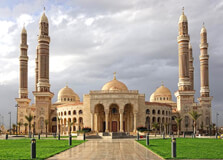
- Home
- Travel Packages
- Top Destination
-
Travel Attraction
By Category
Top Attraction

- Travel Agents
- Car Rentals
- Hotels

The Great Mosque of Sana'a is one of the oldest and most important religious sites in Yemen. Located in the heart of the historic city of Sana'a, this mosque stands as a symbol of Yemen's rich Islamic heritage and architectural splendor. Built in the 7th century during the early days of Islam, it remains a key place of worship and an architectural masterpiece. The Great Mosque is not only an active mosque but also an important historical and cultural landmark, attracting both pilgrims and tourists interested in the Islamic history of the region. How to Reach the Great Mosque of Sana'a, Sana'a, Yemen The Great Mosque of Sana'a is located in the heart of the old city of Sana'a, making it easily accessible from various parts of the capital. If you are staying within Sana'a, you can easily reach the mosque by taxi or on foot, depending on your location. The mosque is within walking distance from many of the key historical sites in Old Sana'a. For international visitors, you will first need to fly into Sana'a International Airport, which is about 11 kilometers (6.8 miles) from the Great Mosque. Once you arrive in the city, you can take a taxi or arrange private transportation to the mosque. Given the political instability in Yemen in recent years, it is essential to check the latest travel advisories and security updates before planning your trip to ensure a safe visit. Weather in Sana'a, Yemen The climate of Sana'a is relatively mild due to its high altitude (approximately 2,200 meters or 7,200 feet above sea level). The weather in Sana'a is typically cooler than the coastal cities of Yemen. Summers (June to September) are warm with temperatures ranging from 20°C to 30°C (68°F to 86°F), while winters (November to February) are much cooler, with temperatures ranging from 12°C to 25°C (54°F to 77°F). Due to this relatively moderate climate, the Great Mosque can be visited year-round, though the cooler months are more pleasant for outdoor exploration. Rain is infrequent but may occur between November and February. It is a good idea to check the weather forecast before planning your visit to ensure you pack appropriately, especially if you're visiting during the rainy season. Timing of Visit The Great Mosque of Sana'a is an active place of worship, so visitors should be respectful of prayer times. The mosque is open to tourists during the day, but it is advisable to visit outside of prayer times, especially the five daily prayers that take place in the morning, midday, afternoon, evening, and night. If you want to avoid large crowds, the best time to visit is early in the morning or later in the afternoon. Although there is no official schedule for visiting the mosque, it's recommended to arrive during daylight hours to fully appreciate the structure and its surroundings. Given the mosque's importance to local worshippers, visitors should dress modestly and respect the sacredness of the site during their visit. Why the Great Mosque of Sana'a is Famous The Great Mosque of Sana'a is famous for its historical and religious significance, as well as its architectural grandeur. Built in 634 AD by the Islamic Caliph Ali ibn Abi Talib, the mosque is one of the oldest in the world and a prime example of early Islamic architecture. It is believed to be the second mosque built in Yemen after the Quba Mosque in Medina, Saudi Arabia. The mosque is renowned for its historical importance in the development of Islam in Yemen. It is considered a vital center for Islamic learning and worship. Not only is it a place of prayer for the local community, but it also serves as an educational institution where students study Islamic jurisprudence, Quranic studies, and other religious sciences. The architectural beauty of the mosque adds to its fame. The mosque features traditional Islamic design elements, such as large courtyards, soaring minarets, and intricate stonework. The mosque's vast prayer hall can accommodate thousands of worshippers, and its intricate plaster and wooden carvings showcase the craftsmanship of early Yemeni artisans. Entry and Visit Details About the Great Mosque of Sana'a, Sana'a, Yemen The Great Mosque of Sana'a is free to enter, but visitors should be respectful of the religious practices taking place. It is essential to dress modestly when entering the mosque, particularly for women. Women are often required to wear a headscarf or a full-body covering, while men should avoid wearing shorts or sleeveless shirts. Some areas may also be off-limits to tourists during prayer times, so it is best to consult with a local guide or mosque staff before entering certain sections of the mosque. It is highly recommended to visit the mosque with a local guide who can explain the history, significance, and architectural features of the building. Many guides are available in Sana'a and can help you navigate the mosque’s layout and provide valuable context for understanding its cultural and religious importance. Guides typically speak Arabic, but some may speak English or other languages. History and Architecture of the Great Mosque of Sana'a The Great Mosque of Sana'a was built during the early Islamic period in the 7th century, shortly after the arrival of Islam in Yemen. It was originally constructed by the order of the Caliph Ali ibn Abi Talib, the cousin and son-in-law of the Prophet Muhammad. The mosque’s construction is closely tied to the spread of Islam in the Arabian Peninsula, particularly in Yemen, which became an early center of Islamic culture. The mosque’s architectural design reflects early Islamic aesthetics. The building is made from local sandstone, and the exterior features intricate carvings and inscriptions. The mosque has a large prayer hall, several courtyards, and a beautifully designed minaret. The minaret, which is one of the oldest in Yemen, is particularly noteworthy for its unique design, which is characteristic of the early Islamic period in the Arabian Peninsula. Over the centuries, the mosque has undergone several renovations and additions, particularly after the 10th century, when it became a significant center for Islamic learning and scholarship. The Great Mosque of Sana'a’s influence spread throughout the region, and it continues to be an important religious site for both locals and visitors from around the world. Things to Do Near the Great Mosque of Sana'a, Sana'a, Yemen When visiting the Great Mosque of Sana'a, there are several other significant historical and cultural sites nearby that are worth exploring. These include: Old Sana'a: A UNESCO World Heritage site, Old Sana'a is known for its medieval architecture, winding streets, and vibrant souks (markets). Visitors can explore the ancient city, visiting traditional houses, shops, and historical landmarks. Al Saleh Mosque: This modern mosque, built in the early 21st century, is one of the largest in Yemen and offers a contrast to the ancient architecture of the Great Mosque. It’s located just a short distance from the Great Mosque. National Museum of Yemen: Located near the Great Mosque, the museum offers a fascinating collection of artifacts from Yemen’s long history, including archaeological finds, Islamic art, and exhibits on the country’s ancient civilizations. Facts About the Great Mosque of Sana'a, Sana'a, Yemen The Great Mosque of Sana'a was built in 634 AD and is one of the oldest mosques in the world. The mosque was constructed by the Caliph Ali ibn Abi Talib, the cousin and son-in-law of Prophet Muhammad. The mosque features a large prayer hall, several courtyards, and a distinctively designed minaret. It remains an important center for religious study and prayer in Yemen. The mosque is considered one of the earliest examples of Islamic architecture in Yemen. Tips for Visiting the Great Mosque of Sana'a, Sana'a, Yemen Respect the local customs: Yemen is a conservative country, so dress modestly when visiting the mosque. Women should wear a headscarf, and both men and women should wear appropriate clothing. Timing your visit: Avoid visiting during prayer times to experience the mosque more freely. Early morning or late afternoon is the best time to explore. Hire a local guide: A knowledgeable guide can provide important historical and cultural context for your visit and help you navigate the site. Check travel advisories: Yemen has experienced political instability in recent years, so make sure to check the latest travel advisories and security information before planning your visit.
Explore More